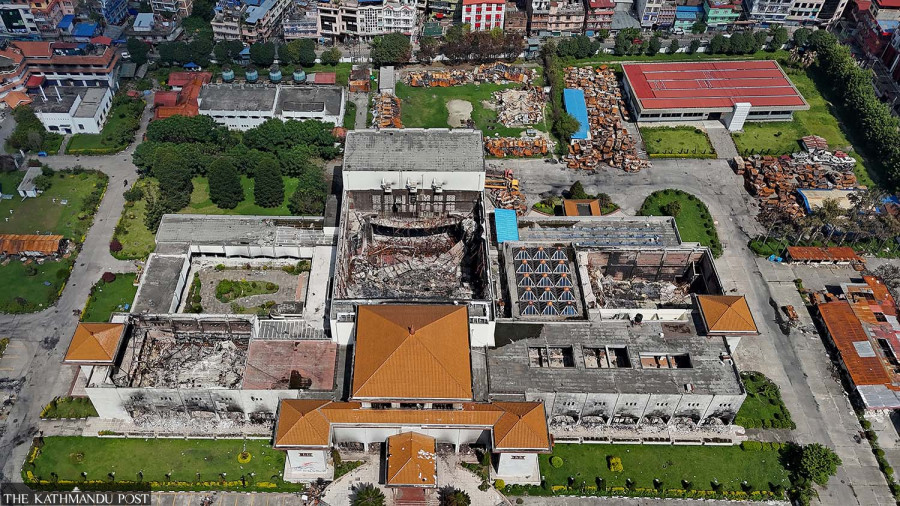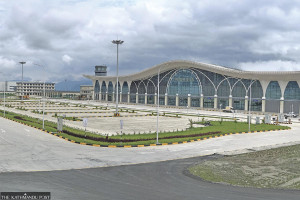National
A third of buildings torched in Gen Z protests fully destroyed
PM Office, parliament, health ministry, Kathmandu District Court get red stickers.
Binod Ghimire
Around one-third of buildings under the federal government that were set on fire during the Gen Z protests on September 8-9 have been completely damaged.
The Department of Urban Development and Building Construction carried out rapid assessments of 440 buildings of 287 federal offices across the country. Of them 134 have been found fully destroyed while 176 have been damaged partially. As many as 130 suffered minor damage. The assessment teams have affixed red stickers, yellow stickers and green stickers to indicate the varying levels of destruction of the buildings.
“Those with green stickers can be used after minor repairs immediately,” said Nisha KC, senior divisional engineer at the department. “Those found fully destroyed and partially damaged in the post-arson rapid assessments need detailed study to ascertain whether they can be reused after repair and retrofitting or need demolition.”
Twenty different teams comprising officials from the department were mobilised to conduct post-arson assessment of the infrastructure under the federal government to ascertain whether they are inhabitable.
Similarly, Nepal Engineers Association carried out rapid assessments of 170 buildings under the provinces which includes provincial assemblies, ministries and other offices.
Likewise, offices under 80 local units were also assessed by the association. “We assessed all the destroyed and damaged structures under the provinces. However, we could not cover all the structures of the local units as several of them are conducted on their own,” said Subash Chandra Baral, president of the association. “Around 25 percent of the structures we have assessed have been completely damaged.”
KC said they have already started the detailed structural assessment in partnership with the Tribhuvan University's Institute of Engineering and other organisations. The detailed assessment of the partially damaged structures will be carried out in the first phase.
“We plan to carry out detailed assessments of all the structures in two months. The repairs and retrofittings will be completed by the end of the current fiscal year,” said KC. There are nine months for the current fiscal year while the current Sushila Karki government has five months to hold the elections and handover the authorities to the elected representatives.
Several buildings including the Prime Minister’s Office, federal parliament building, the Ministry of Health and Population, Kathmandu District Court among others have got red stickers. The experts, however, say red stickers doesn’t necessarily mean the building needs to be pulled down immediately but they are uninhabitable for now.
The intensity of the destruction depends on the heat and the duration the particular structure was under fire, they say. Unlike during an earthquake, when an entire building is affected, fire damage might not be equally intense throughout. The areas where the fire was severe are damaged, but other parts could be usable.
Fire with a temperature ranging from 100°C to 200°C begins to reduce the moisture present in cement and concrete, according to experts. This moisture plays a role in holding the bricks, cement and rods together. However, as the heat gradually evaporates moisture, the internal bonds of the structures start to weaken, which in turn reduces the building’s load-bearing capacity and strength.
Temperatures between 300°C and 400°C can even alter the chemical composition of the cement used in buildings. Under a temperature exceeding that, the structure can suffer so much damage that it becomes completely unusable.
The Gen Z protest that began on September 8 turned violent after 19 youths–17 outside the federal parliament at New Baneshwar, and two in Itahari—were killed in police firing. The next day, protesters not only torched the houses of then-prime minister KP Sharma Oli and other leaders, but also seized control of properties under the legislature, the judiciary and the executive and set them on fire. Some of the key buildings including the Supreme Court were burning for days. The arson was not confined to Kathmandu but across the nation leading to the loss worth hundreds of billions rupees.




 19.12°C Kathmandu
19.12°C Kathmandu














